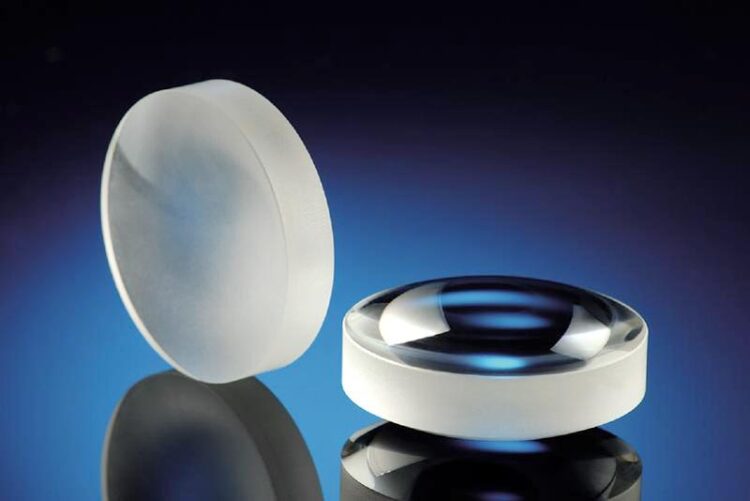The dawn of laser-based optics production

A fused silica optic before and after laser polishing.
© Fraunhofer ILT, Aachen, Germany
The optical industry almost completely relies on mechanical processes in its process chains. This, however, could soon change. The Fraunhofer Institute for Laser Technology ILT in Aachen is pushing ahead with digitally controlled laser processes that save both time and costs when aspheres and freeform optics are shaped, polished and their final shape is corrected. Fraunhofer ILT will be presenting the laser-based process chains of the future at the OPTATEC trade fair from May 14 to 16, 2024 in Frankfurt and at the 1st Aachen Conference “Laser-based Optics Production“ on October 15 to 16, 2024.

The light scatters on the surface of the polished asphere at the back. The same optics can be seen in the laser-polished state at the front. © Fraunhofer ILT, Aachen, Germany.
The ongoing trend towards aspheres and freeform optics is pushing traditional process chains – ones based on purely mechanical processing in the optical industry – to their limits. To overcome this obstacle, Fraunhofer ILT will be presenting its vision of highly flexible laser-based process chains for optics production at the OPTATEC 2024 trade fair in Frankfurt.
Even today, individually designed aspheres and freeform optics can be produced using laser processes. “The key advantage of the laser is its digital control in conjunction with massless and contactless material processing,“ explains Dr. Edgar Willenborg, Head of the Polishing Group at Fraunhofer ILT. Since the process is numerically controlled and does not need forming tools, processing times no longer depend on the lens shape. This results in clear cost benefits, especially for complex geometries. “As no consumables are used, laser processes also minimize the amount of cleaning required,“ he explains. This flexibility now needs to be transferred to industrial applications: initially as individual laser-based processes and then, in the long term, as fully laser-based optics production, from shaping and polishing to nanometer-precise shape correction.
Shaping, polishing or shape correction by laser
This laser-based process chain of the future is based on shaping by ablation with ultrashort pulse (USP) lasers or Selective Laser-induced Etching (SLE). The Fraunhofer ILT’s agenda also includes laser polishing of glass and, if required, polymer-based lenses as well as precision shape correction in the high-end sector. The latter has already been demonstrated by a team led by Emrah Uluz, a research associate in the Fraunhofer ILT’s Shape Correction of Optics research field, using CO2 and USP lasers.
CO2 lasers are also used for laser polishing. Four fifths of their energy is absorbed in the uppermost layers of glass. The penetration depths are between 3 and a maximum of 30 µm. This is where the glass melts, transforms into a honey-like state and then automatically smoothes out as it cools on account of the surface tension. This remelting of the surface layer, including surface smoothing due to interfacial tension, results in outstanding surface qualities: Roughness in the sub-nanometer range sets new standards and predestines laser processes for applications that require the highest optical performance.
Laser-based processes are already supplementing the mechanically dominated process chains in the industry as they can eliminate the micro-roughness that causes light to scatter and lenses to appear cloudy. “We are systematically working on using hybrid approaches like this to create all-round laser-based process chains in optics production,“ explains Uluz. The spectrum ranges from micro and macro optics or individually shaped special optics to glass bodies that can also be structured internally using SLE. Mechanical and laser-based processes still complement each other, but the clear goal of the Fraunhofer ILT is to make the advantages of laser technology useful for all areas of optics production.
Individualized mass production by laser
At OPTATEC 2024 (Hall 3.1 / Stand 610), Fraunhofer ILT will provide insights into the status quo of development and present the vision of completely laser-based process chains. “Laser-based processes offer considerable advantages as they can save both energy and resources, especially for complex geometries,“ says Willenborg. Laser processing will pave the way for wider use of aspheres and freeform optics. This alone reduces the design and cost of optical systems. If the shape of the optics can be adapted to the specific requirements, highly complex optical systems can be manufactured with significantly fewer individual components.
For those interested in discussing the potential of laser-based optics manufacturing in greater detail, we recommend attending the “Conference on Laser-based Optics Manufacturing“ organized by Fraunhofer ILT for the first time, in addition to visiting OPTATEC. The conference will take place on October 15 and 16, 2024, parallel to the 6th Conference on Laser Polishing LaP at the Aachen research institute.
Wissenschaftliche Ansprechpartner:
Dr. Edgar Willenborg
Head of Polishing Group
Telephone +49 241 8906-213
edgar.willenborg@ilt.fraunhofer.de
Emrah Uluz M.Sc.
Polishing Group
Telephone +49 241 8906-282
emrah.uluz@ilt.fraunhofer.de
Fraunhofer Institute for Laser Technology ILT
Steinbachstraße 15
52074 Aachen, Germany
www.ilt.fraunhofer.de
Weitere Informationen:
Media Contact
All latest news from the category: Process Engineering
This special field revolves around processes for modifying material properties (milling, cooling), composition (filtration, distillation) and type (oxidation, hydration).
Valuable information is available on a broad range of technologies including material separation, laser processes, measuring techniques and robot engineering in addition to testing methods and coating and materials analysis processes.
Newest articles

A new puzzle piece for string theory research
Dr. Ksenia Fedosova from the Cluster of Excellence Mathematics Münster, along with an international research team, has proven a conjecture in string theory that physicists had proposed regarding certain equations….

Climate change can cause stress in herring larvae
The occurrence of multiple stressors undermines the acclimatisation strategies of juvenile herring: If larvae are exposed to several stress factors at the same time, their ability to respond to these…

Making high-yielding rice affordable and sustainable
Plant biologists show how two genes work together to trigger embryo formation in rice. Rice is a staple food crop for more than half the world’s population, but most farmers…



